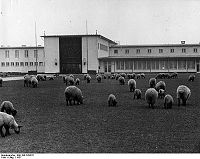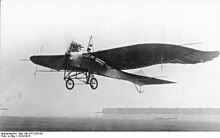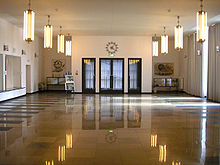- Cologne Butzweilerhof Airport
-
Butzweilerhof
Flughafen Köln (1926-51)
RAF Butzweilerhof (1951-67)
Airport Building in 1936 (Landside) IATA: none – ICAO: none Summary Airport type Former Airport Serves Cologne Location Cologne Coordinates 50°59′05.3″N 6°53′29.1″E / 50.984806°N 6.891417°ECoordinates: 50°59′05.3″N 6°53′29.1″E / 50.984806°N 6.891417°E The Butzweilerhof is the former civil airport of Cologne. It was established as a training airfield in 1912 and saw airline service from 1922 until the 1950s. It was replaced by the Cologne Bonn Airport. The airport buildings from 1935-36 are listed monuments and a rare example of airport architecture from the Interwar Period.
Contents
History
Before regular aviation activities at Butzweilerhof started, the area north of Cologne was sporadically used by airships. The military Zeppelin Z II arrived in Cologne in August 1909 and was based in a nearby hangar until it was destroyed in a storm in April 1910. In addition a Blimp designed and manufactured 1909 by Clout Gummiwerke from nearby suburb Nippes was temporarily stored at this hangar.[1]
Beginnings and World War I
In 1912 the Air Arm of the Imperial Army (Luftstreitkräfte) established an air station at Butzweilerhof and hangars, maintenance facilities as well staff accommodations were build. The station went fully operational in spring 1913 and was used for initial pilot training before and during World War I. Among the pilots receiving their first flying lessons at Butzweilerhof was Manfred von Richtofen.
Interwar period
After the war the Royal Air Force used the airfield primarily in a supply role for British troops. From 1922 Instone Air Line provided a first regular passenger service to London via Brussels. The airfield was returned to the city of Cologne in 1925 and the civil airport was officially opened one year later. In order to fulfil requirements of modern aircraft adjacent property was bought. The enlarged airfield had a circular shape and occupied around 30 hectares. Than mayor of Cologne Konrad Adenauer supported the development of Butzweilerhof into a modern airport, but due to limited financial resources only small progress was made during the late 1920s and early 1930s. Some facilities in use still originated from the imperial air station, while newer ones were basic and partially made of wood.
After 1933 the expansion plans were adopted by the new national-socialist government of Cologne and a major expansion project started in 1935. It served as a job creating program for around 1,100 unemployed. In the course of this project a new airport complex consisting of a passenger building, workshops, two hangars and a control tower was erected. The new facilities were opened after only one year of construction time in June 1936, a few weeks prior to the Olympic Games in Berlin.
Largest operator was pre-war Deutsche Luft Hansa. Foreign operator such as Imperial Airways, Air France and Sabena accounted for approximately one out of four movements. For some time Butzweilerhof was second in Germany only to Berlin Tempelhof and dubbed Luftkreuz des Westens (Air Junction of the West). Traffic figures reached a peak in 1938 with 6,390 aircraft departures as well as 49,938 arriving and departing passengers.
World War II and Cold War
During World War II Butzweilerhof was predominately used for emergency landings and as field repair station for fighter aircraft. The Royal Air Force moved in again after the war and the airfield became RAF Butzweilerhof. Some airline service was restarted but ceased with the opening of Cologne Bonn Airport.
The RAF base closed in the 1960s and some airport facilities were subsequently used by non-flying units of the German Army. The airfield stayed in use until 1996 by army aviation units of the Belgian Armed Forces from nearby barracks.
Airport buildings
The airport buildings from 1935-36 were designed by Hans Mehrtens, Chief Building Director of Cologne since 1930. An airport road was build in straight line to the city centre and the airport facilities were positioned directly at its end. The group of buildings is approximately 270 meters long and arranged slightly curved to follow the perimeter of the circular airfield.
Passenger building
The passenger building is a two storey flat roof construction parallel to the airfield perimeter. The passenger traverses the building through the lobby which is aligned with the former airport road and divides the building into a western and eastern wing. Arriving passengers were looking directly at the distant Cologne Cathedral when leaving the building to the landside.
The landside portal of the lobby is decorated with a relief made by the sculptor Willi Meller and features the eagle of the Weimar Republic and three crowns derived from coat of arms of Cologne.
Most of the ground level is brought forward towards the tarmac to form roof terraces. The west wing houses a café and a restaurant while the east wing was occupied by airport and airline offices.
Workshops
The workshops (Betriebshof) were located in a horseshoe-shaped one storey building. Staff and maintenance facilities are grouped around an inner courtyard, while several parking garages provided direct airside access for ambulance vehicles and fire engines. The building was heavily altered after the war and several extensions had to be broken-up to recreate the original state.
Hangar I
Hangar I has interior dimensions of 68.4 meters in width and 34.8 meters in depth. It is large enough to accommodate several contemporary Junkers Ju 52/3m with a wingspan of 29 meters and a length of 19 meters. The building was lastly used as repair facility for heavy military vehicles and had the original hangar doors replaced with roll-up doors.
Control Tower
The Control Tower completes the airport complex and sets an antipode to the passenger lobby at the opposite end. The tower features strips of ribbon windows in Bauhaus style. The control level on top is glazed all around and had to be reconstructed after its accidental demolition during the war.
Hangar II
A second hangar with roughly the same dimensions as Hangar I was erected in right angle behind the control tower. On two sides the building is surrounded by classrooms that were used for training of flying staff and maintenance personnel. The hangar still features the original hangar doors.
Current days
The premises of the former airfield were primarily used to extend the nearby business park while the airport buildings underwent restoration.
Airport buildings
The airport buildings - listed as monuments since 1988 – were extensively renovated between 1995 and 2007 with the intention to use them for cultural activities and an aviation museum. The apron will be converted into a park to form the centre of the new suburb Butzweilerhof.[2]
Airfield
The former airfield as well as its surroundings were temporarily used for activities such as music festivals and than gradually converted into a business park. In 2010 the Stadtbahn was extended from a nearby terminus to Butzweilerhof.
References
- ^ 80 Jahre zivile Luftfahrt in Köln; HG: Flughafen Köln/Bonn GbmH und Stiftung Butzweilerhof. Köln, 2006, ISBN 3-7616-1995-2, German
- ^ KstA “Restoration works at Butzweilerhof“ 23 August 2009 (German)
External Links
Categories:- Defunct airports in Germany
- Ehrenfeld, Cologne
- Airports established in 1912
Wikimedia Foundation. 2010.



